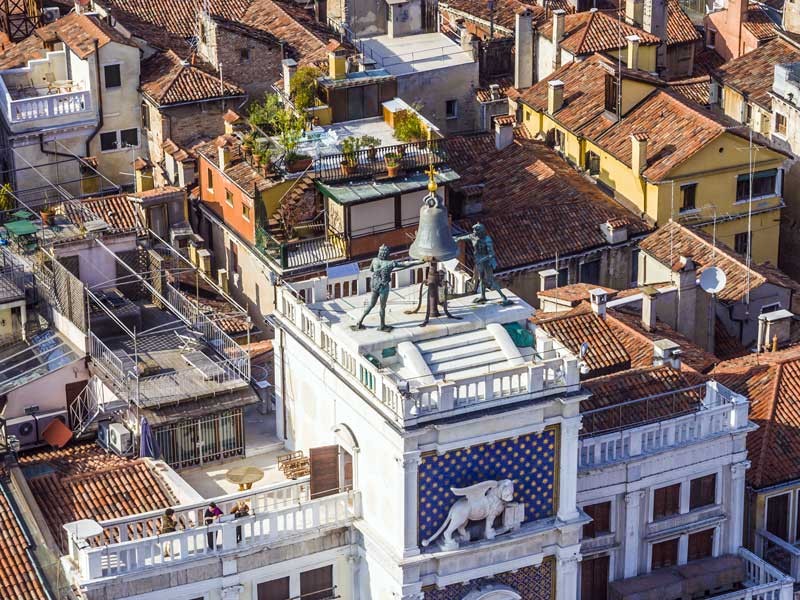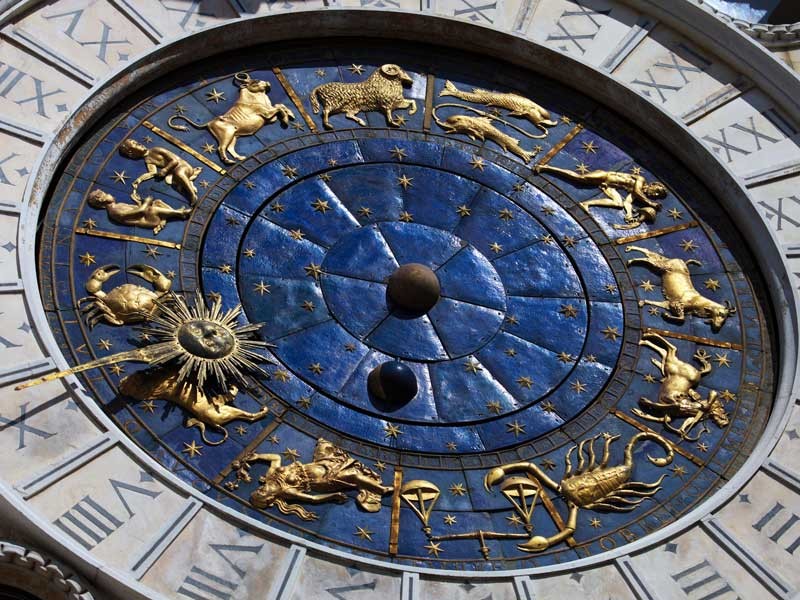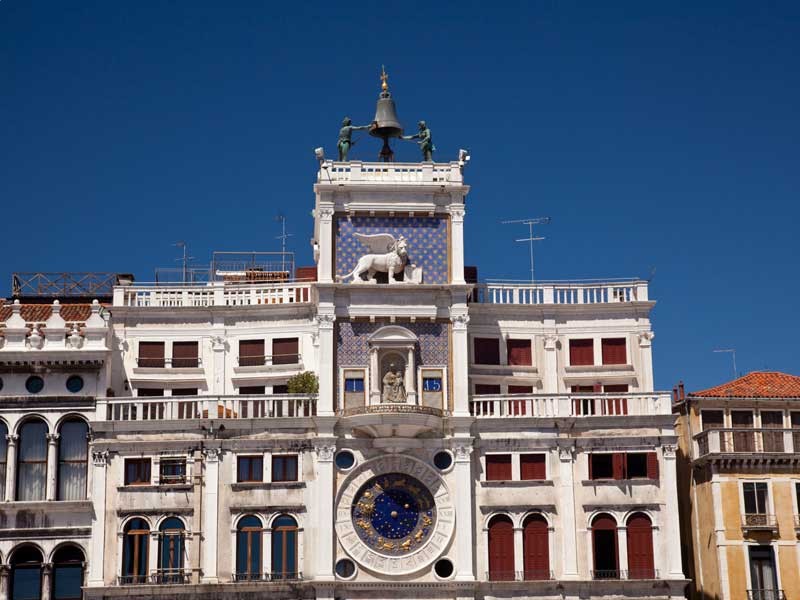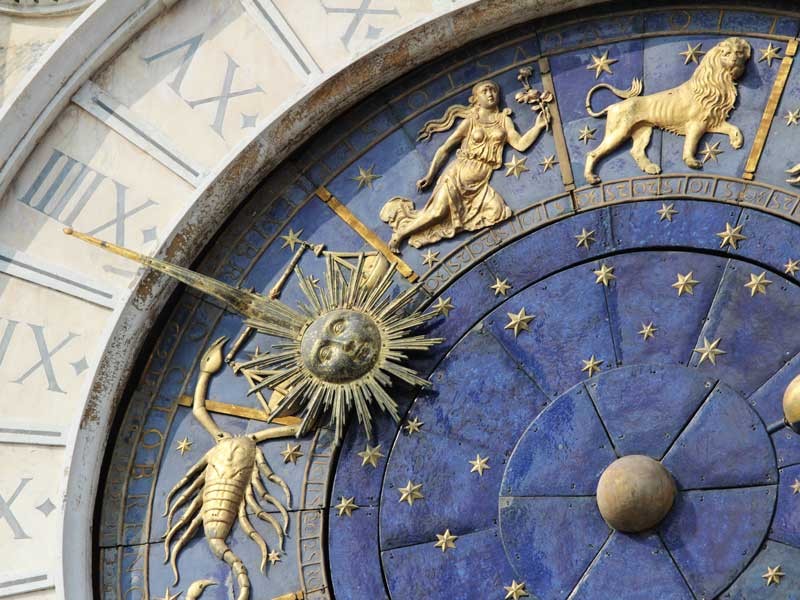Visitors can see the interesting network of pulleys, weights and counterweights as they silently rise and fall at regular intervals. A metal spiral staircase then takes one towards the complex workings of the clock proper; visitors get a close view of the mechanism and of the gears linking it with the south and north clock faces, overlooking St. Mark’s Square and the Mercerie respectively
Info & Booking
Holders of the ticket for the Clock Tower get free admission to the Museo Correr, the National Archaelogical Museum and the State Rooms of the Biblioteca Marciana
Reservations must be made with a minimum of 1 day notice.
Save time in ordering! Add into your basket all the museum tickets you want, then fill the form and send the request.
Before making your reservation, please, read the Ordering Informations
NOTE: The visit is confirmed 90 days before the date, so reservation guarantees the inclusion on the waiting list and delivery of the voucher as soon as we receive it from the Tower management. Charge to credit card made â??â??the business day following the request.
IMPORTANT NOTICE: After succesfully completing a reservation, you will receive two e- mails: the copy of your order (immediately after submitting your order) and the confirmation mail (one working day after). In order to receive them, please make sure you insert your e-mail address correctly and check that your anti-spam filter or antivirus are not blocking mails from our address [email protected]. Special attention for AOL mailbox users.
PLEASE NOTICE: Confirmed time is not always the same time you requested; museum automatically confirms the closest available time on the same date if requested time is sold out.
The interior of the Clock Tower comprises various small spaces linked by narrow and steep stairs; thus the building is inaccessible for those with walking difficulties and the visit is not recommended for pregnant women or for those who suffer from claustrophobia, vertigo or heart conditions and respiratory diseases.
All visitors must be over 6 years of age.
Visits:
Italian: everyday at 1pm, and 4pm
English: from Monday to Wednesday: 11am and 12noon; from Thursday to Sunday: 2pm and 3pm.
French: From Monday to Wednesday: 2pm and 3pm; from Thursday to Sunday: 11am and 12noon.
Afternoon visits not available in summer months
Cancellation Policy:
For cancellations once a confirmation code has been assigned to the reservation, up to 5 after confirmation has been sent, we can refund cost of unused tickets minus service fee (reservation fee and online booking fee). For further cancellations and no shows, no refund is possible.
Before You Book
PLEASE NOTE: Immediately after submitting an order, you will receive two email. The first email contains your order summary (this one you receive immediately after placing your order), the second email confirms your successful payment (one business day after placing the order). In order to receive these two emails, please make sure that you enter your email address correctly and check that antispam or antivirus filters do not block emails from our [email protected] address. Users of AOL, Comcast and Sbcglobal.net need to pay special attention to this, please. Vouchers will also be available, one business day after the request, at your dashboard.
IMPORTANT NOTE: The time you select on the order form is your preferred time. The closest available time, which can be anytime during opening hours on the selected date, will be automatically confirmed if your preferred time is no longer available.
Intro
Visitors can see the interesting network of pulleys, weights and counterweights as they silently rise and fall at regular intervals. A metal spiral staircase then takes one towards the complex workings of the clock proper; visitors get a close view of the mechanism and of the gears linking it with the south and north clock faces, overlooking St. Mark’s Square and the Mercerie respectively
Clock Tower
The Moors\' Clock Tower is one of the most famous architectural landmarks in Venice, standing over an arch that leads into what has for centuries been Venice\'s ancient center of trade, the old Mercerie. The Tower and its large Astronomical Clock, a masterpiece of technology and engineering, form an essential part of the very image of Venice. They have measured out the flow of life and history within the city for more than five hundred years.
Guided tours to all four floors are now available, only upon reservation, and accompanied by an expert guide.
A first small flight of stone steps leads up to a little room in which the history of the Clock Tower is explained. Here you can see the network of pulleys, weights, and counterweights as they silently rise and fall at regular intervals.
Climb the beautiful wrought iron spiral staircase towards the complex workings of the clock proper. Get a close view of the mechanism and the gears linking it with the south and north clock faces, overlooking St. Mark’s Square and the labyrinth of little streets of the Mercerie.
A further staircase leads up to the next floor, where you can see the wooden statues of the Magi and the Angel as well as the two ornate doors from which these statues emerge in procession twice a year, on the feast days of Epiphany and Ascension. Here you can also see inside the mechanism of the clock barrels which indicate the hours and the minutes.
Going even higher in the tower you reach a room with components belonging to the 15th century clock mechanism. You can also access the two side terraces and, via a steep spiral staircase, the Two Moors Terrace. Here, you not only get a close look at the two colossal statues, but can also enjoy a splendid view of Venice and its lagoon.
The clock dial facing the Piazza comprises four different elements. The first one is a fixed marble circle inscribed with Roman numerals signifying the hours. The second one is a mobile larger ring, bearing the signs of the zodiac and the related constellations, the names of the months, and the number of the days. The third element is a thinner ring bearing the hour hand in the form of a sun with a long ray. The fourth and final element is an inner disk with the Earth (at the center) and the Moon, which rotates on its axis to represent its various phases.
The moving rings are made of wood faced with blue enameled copper, while the numbers and the stars are made of gilded, embossed copper. The signs of the zodiac are particularly well-crafted and date from the original clock-face. With the passage of days and months, the different speeds of the rings move the symbols of the sun and moon through the various constellations of the zodiac.
On the other hand, the clock-face over the Mercerie comprises three separate elements. The first is an outer fixed marble ring, inscribed with Roman numerals signifying the hours. A circle of mosaic scattered with golden stars is at the center of this ring. Inside this is a moving disk, about 67 inches in diameter, decorated with flaming rays in embossed copper. Traces of the original gilding are still visible on this face of the sun indicating the hours. At the center is a copper lion of St. Mark. Once gilded, it serves to cover the end of the axle transmitting power to the clock-hand.
When the Clock Tower was built in 1499, the Three Kings and the Angel with the Trumpet were designed to come out every hour from the loggia on the second level of the structure and pass in procession before the statue of the Madonna and Child.
However, the delicacy of the complex mechanism was subject to great wear and tear over time - so eventually the procession had to be reduced in frequency - or stopped altogether. Still in use today, it comes into operation only twice a year: on Epiphany and the Feast of the Ascension. The actual wooden statues of the Three Kings and the Angel were restored by Giovanni Battista Alviero in 1755.
Originally, the two doors from which the Three Kings and the Angel emerged in procession were wooden structures faced with painted and gilded metal, and decorated with two gilded angels of embossed metal. Since 1858, these doors have been absent for most of the year, replaced by two metal openings which are decorated with gilded geometric motifs and make it possible to read the panels of the hours and minutes on the two rotating barrels installed by Luigi De Lucia.
The two giant bronze statues, know as the “Moors” because of the patina on the metal, were cast in 1497 by Ambrogio della Ancore. The bodies are hinged at the waist to permit the movement of striking the bell. The bell, surmounted by a gilded sphere and a cross, was also cast in 1497. During the middle of the 19th century, the tower\'s roofing was replaced, and the bell and the two Moors were raised about three feet above their original level.
Please Note:
The interior of the Clock Tower comprises various small spaces linked by narrow and steep stairs. The building is therefore inaccessible for those with walking difficulties, and the visit is not recommended for pregnant women or for those who suffer from claustrophobia, vertigo, or heart conditions and respiratory diseases. Visitors must be at least 6 years old.
Cancellation Policy
Once a confirmation code has been assigned to the reservation we can refund the cost of unused tickets minus a service fee (reservation fee and online booking fee) up to 5 days after the confirmation is sent. No refund is possible for or cancellations for later cancellations, and for no shows.




